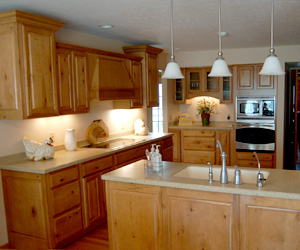Kitchen Remodeling
Basic Tips for Kitchen Remodeling
 Kitchens come in all shapes and sizes, which accounts for a lot of their challenge — and a lot of their appeal. The same cabinets, appliances, and surfacing materials can look entirely different in someone else’s home than in yours. Stock cabinets can be given a unique look with virtually unlimited specialty finishes and a change of hardware. If your budget can accommodate custom cabinets, your choices are even greater. Countertop materials already come in a great array of choices, but they can be customized even further with special routing or inset bands of another color or material. The same goes for flooring, walls, and in-kitchen dining furniture. So even if your kitchen is small and ordinary, it’s not hopeless!
Kitchens come in all shapes and sizes, which accounts for a lot of their challenge — and a lot of their appeal. The same cabinets, appliances, and surfacing materials can look entirely different in someone else’s home than in yours. Stock cabinets can be given a unique look with virtually unlimited specialty finishes and a change of hardware. If your budget can accommodate custom cabinets, your choices are even greater. Countertop materials already come in a great array of choices, but they can be customized even further with special routing or inset bands of another color or material. The same goes for flooring, walls, and in-kitchen dining furniture. So even if your kitchen is small and ordinary, it’s not hopeless!
You can transform it into a remarkable space unlike anybody else’s. Manufacturers and designers have seen it all, and the end result is that you can have all the amenities you want and need, even in a tiny kitchen. Savvy, space-saving products are available for the owner of the apartment-size condo, co-op, or townhouse kitchen. You’ll find that convenience doesn’t have to come only in the large economy size.
 To create a distinctive space, your first move is to look at your kitchen with an eye to what might serve as a focal point. A large window, alcove, or long wall can be the start. Take advantage of a bank of beautiful windows with an eye-catching counter that runs the length of the window wall. If you love to entertain and are lucky enough to have ample space, consider setting your room up to include two back-to-back kitchens; one with a full-size range, a fridge, ovens, and a sink, and the other with an ice-maker, a wine chiller, a second sink, a mini-fridge, and a microwave, plus an abundance of storage. Pretty much anything you dream up can be executed with the help of a talented design team. It’s up to you!
To create a distinctive space, your first move is to look at your kitchen with an eye to what might serve as a focal point. A large window, alcove, or long wall can be the start. Take advantage of a bank of beautiful windows with an eye-catching counter that runs the length of the window wall. If you love to entertain and are lucky enough to have ample space, consider setting your room up to include two back-to-back kitchens; one with a full-size range, a fridge, ovens, and a sink, and the other with an ice-maker, a wine chiller, a second sink, a mini-fridge, and a microwave, plus an abundance of storage. Pretty much anything you dream up can be executed with the help of a talented design team. It’s up to you!
Whether your space is large or small, and whether the end result you want is pretty or pretty wild, you’ll do best if you stick close to the following basic recommendations.
- Try to keep the straight-line distance between the sink, fridge, and cooktop between 12 and 23 feet.
- Position the sink between the other two appliances, since it’s used most often. (The sink’s location may depend on pre-existing plumbing lines.)
- Allow for 36 inches of counterspace to the right and 30 inches to the left of the range and sink if at all possible; if not, allow a minimum of 24 inches and 18 inches.
- It’s tempting to place a tall fridge and built-in wall oven next to each other, but try not to; each needs its own landing space on both sides of the appliance for safety.
- Try to include a minimum of 10 linear feet of both base cabinets and upper cabinets.
- Utilize lazy Susans to make potentially wasted corners fully functional.
- Use pull-out drawers rather than reach-in, conventional cabinets for greatest convenience. If you’re retro-fitting existing cabinets, have pull-out trays installed.
- Consider barrier-free design and products. They make life easier for children, pregnant women, and seniors as well as individuals with disabilities. They’ll also add to the longevity of your kitchen.
The biggest factor influencing what type of kitchen you come up with will be the shape of the room itself. In the next section, we will explore some kitchen-shape considerations.
